
The eutrophication of surface water and coastal zones is expected to increase globally until 2030. While the rate of eutrophication may stabilise in developed countries, researchers believe that it may continue to worsen in developing countries. This will inevitably lead to the degradation of coastal areas and surface water quality, placing further strain on two thirds of the world’s population who are currently already living under water stress.
Plants require water, sunlight, and carbon dioxide to photosynthesise, but they also need nitrates and phosphates to thrive. While farmers put down fertiliser enriched with nitrates and phosphates to grow crops, not all plants are efficient at soaking up all of the nutrients. Excess nitrates and phosphates may be carried away by rain as agricultural runoff, and may mix with industrial effluent before finding their way into larger bodies of surface water, like ponds, lakes, reservoirs, and oceans. (1) With an overabundance of nutrients in the water, algae, phytoplankton, and even plants in the water quickly absorb the nitrates and phosphates and grow to vast quantities. This leads to algae blooms and entire bodies of surface water may be covered in layers of plant growth. (2) The floating layer of algae forms a barrier on the surface of water, and when the nutrients are used up by the algae bloom and no longer support so much life, the excess algae, phytoplankton and plants die off and sink to the bottom of the water.After the algae bloom dies, harmful toxins are produced by microbes, bacteria, and other decomposers and this process takes up even more dissolved oxygen from the water. (3) With so much organic matter decomposing rapidly, nearly all of the oxygen in the water is used and aquatic fauna will start to die. This causes yet more death and more decomposition, further reducing the oxygen content in the water. At this point, a positive feedback loop has been created, and it will take a body of water an extremely long time to recover from this anoxic state.Eutrophication is a serious concern as it voids the aquatic ecosystem of dissolved oxygen, which results in a loss of biodiversity and creates a negative impact on ocean fisheries. (4) Habitat degradation of aquatic fauna and fish die-offs correspond with an increase in nitrate and phosphate levels. Algae-produced toxins may also cause fish mortality, making fishing activities in eutrophic water dangerous. It has been recorded that such toxins bioaccumulate in shellfish and small fish such as anchovies and sardines, which then further poison larger marine mammals or birds that feed on contaminated fish. (5) Such incidents have been observed in Russia, Colombia, Vietnam, China, Canada, Turkey, Indonesia, and France. (6) The eutrophication process kills many native marine species in water bodies, and should anoxic conditions occur in the ocean, it may cause corals to bleach and die. All around, this would greatly damage fragile marine ecosystems and lead to a decrease in biodiversity. (7) Clean Earth Technologies is currently in the process of developing a polysulfide-fertiliser composite, which can be matched to the needs of specific plants to allow a slow and controlled release of nitrogen, phosphorus, and potassium nutrients. This composite differs from traditional slow-release fertilisers, as it does not use a typical agriculture polymer coating, which can result in the release of residual, persistent microplastics. Because of its versatility in managing the release of fertiliser nutrients, the composite can be applied to a variety of farming practices. Slow release of nutrients will help reduce loss of nitrates and phosphates in tailwater, prevent nutrient burn, supply nutrients at a level tuned to the plant’s growth, and reduce the environmental impact from agricultural run-off.
____________________________
[1] Fareed A. Khan and Abid Ali Ansari, “Eutrophication: An Ecological Vision,” The Botanical Review 71, no. 4 (December 2005): pp. 449-482, https://doi.org/10.1663/0006-8101(2005)071[0449:eaev]2.0.co;2.[2] Ansari, A. A., and F. A. Khan. "Nutritional status and quality of water of a waste water pond in Aligarh showing blooms of Spirodela polyrrhiza L.(Shleid)." Journal of Ecophysiology and Occupational Health 2, no. 3 (2002): 185-189.[3] R. Eugene Turner and Nancy N. Rabalais, “Coastal Eutrophication near the Mississippi River Delta,” Nature 368, no. 6472 (1994): pp. 619-621, https://doi.org/10.1038/368619a0.[4] “Back to Our Common Future – Sustainable Development in the 21st Century (SD21) Project,” Back to Our Common Future – Sustainable Development in the 21st century (SD21) project (United Nations DESA), accessed September 7, 2020, https://sustainabledevelopment.un.org/content/documents/UN-DESA_Back_Common_Future_En.pdf.[5] Tim Stephens, “Large Bloom of Toxic Algae under Way in Monterey Bay and Beyond,” UC Santa Cruz News, June 2, 2015, https://news.ucsc.edu/2015/05/algal-bloom.html.[6] For more on the impact of such algae blooms and the resultant fish die-off occurrences, see, for a case in Vietnam, Linh Nhat, “Thanh Hoa: Locals Wear Masks as Smell from Dead Fish Overpowering,” Thanh Hoa: Locals wear masks as smell from dead fish overpowering – News VietNamNet (Vietnamnet.vn, July 19, 2016), https://english.vietnamnet.vn/fms/society/160721/thanh-hoa–locals-wear-masks-as-smell-from-dead-fish-overpowering.html; and for a case in Canada, see, Karen Graham, “Massive Fish Kill in Quebec's Yamaska River Puzzle Scientists,” Massive fish kill in Quebec's Yamaska River puzzle scientists (Digital Journal: A Global Digital Media Network, July 4, 2016), http://www.digitaljournal.com/news/environment/tens-of-thousands-of-fish-dead-in-quebec-s-yamaska-river/article/469215.[7] “Sustainable Development in the 21st Century (SD21) .:. Sustainable Development Knowledge Platform,” United Nations (United Nations), accessed September 7, 2020, https://sustainabledevelopment.un.org/resources/sd21.
